When your washing machine drains slowly or doesn’t drain at all, it could be a sign that the drain hose needs to be replaced.
Replacing the drain hose on your washing machine is a quick and easy project.
In this topic, we will go through the process of replacing the drain hose on your washer safely.
How does the drain hose function?
The main function of the drain hose is to simply assist the washer in flushing out the wastewater from the washtub as required.
One end of the drain hose is fixed to the washing machine’s rear that has a small raised port.
And the opposite end is secured with a clamp or brace to a pipe that goes into the sewage system.
The draining activity automatically takes place after the rinse cycle, post which the washtub sets to spin and squeezes out the leftover water.
So, A drain pump inside the washing machine directs the wastewater from the washtub loaded with laundry towards the drain hose. It is further carried to the outlets such as either a sink pipe of the bathroom or basin whichever stands closer to the washer.
In some cases, the drain hoses are connected to a waste pipe that throws it into the sewer system.
If the hose is clogged, water won’t be able to flow freely and your machine will not function efficiently. Most often, this occurs when hair and soap residues accumulate inside the hose.
Therefore, if you leave the clogged drain unaddressed, it may choke and impact the other components.
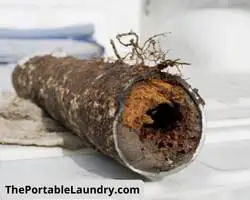
A clogged drain hose can lead to severe damage and put your washer to a halt.
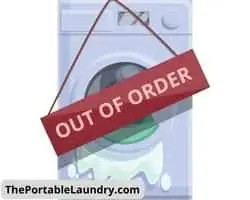
What Are Drain Hose Made Up Of?
They are usually made up of flexible and durable plastic, rubber or even using metal such as stainless steel.
These days, manufacturers have improved their abilities to produce a wide range of long-lasting drain hoses.
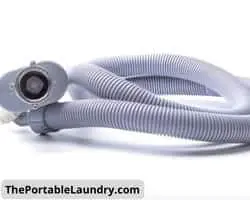
Drain hoses are now made from a combination of materials, but the most favored ones are braided stainless steel of the highest grade, hard plastic, PVCs, and standard rubber.
They are molded into flexible pipes in different sizes suitable for washers and other household and commercial equipment.
Where do you fix a drain hose in a washing machine?
The drain hose is usually fixed on the lower back panel of the washer or at the bottom.
Depending on your washer type you may find them attached to the center or may be at the top of the washer’s back panel.
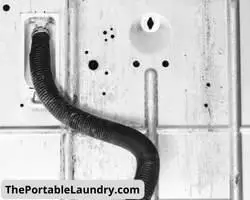
Simply locate the actual position through the user manual of your washer.
To fix the drain hose you will need to push them over to the machine’s drain outlet pipe.
After they are fixed to the outlet pipe, a ring clamp can be used to tighten them.
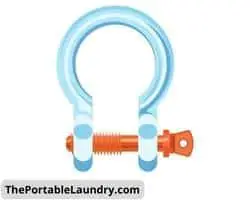
Ring clamps are the most common locking method used for drain hoses that include spring support for sturdy gripping.
Some washers have a built-in clamp, while others require the use of a separate clamp that comes with the drain hoses.
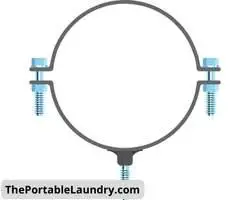
You may also make use of bands and straps to fix the drain hoses and they can be bought from any hardware or home improvement store.
How do the drain hoses wear out?
For a worn-out drain hose, there can be a variety of reasons and the most common cause is clogging.
The clogging can be a result of soap scum, lint accumulation, mold and mildew formation, detergent and dirt residues, grease, and oil from clothing.
Over time an uncleaned drain hose can wear out due to severe clogging, therefore it needs to be cleaned every couple of months.
Another common cause of a worn-out drain hose is physical damage such as accidentally pulling them from the machine, being chewed by mice, or kinking.
A clogged drain hose can lead to leakage and may also result in water flowing back into the machine.
How to replace the drain hose?
Replacing the drain hose in a washing machine is a periodic maintenance task that can be easily done at home.
Let us look into the steps below to replace a drain hose of a washer.
No matter if it is a top loader or a front loader the replacement task is quite simple.
Just be sure to carefully follow the below steps.
Things Required:
- Screwdriver
- Plier
- A container and a large towel (For water spills)
- Replacement hose
- The user manual of your washer’s model
Step 1: Unplug the Power & Water Supplies
You will have to access the lower back panel of the washer.
And then, unplug the power and the water supplies, so that you can easily move your washer away from the back wall.
Step 2: Locate the Hoses
Locate the drain hose at the lower back of the washer or simply refer to the user manual of your washer model.
You may look for the drainage hose connected to the machine’s discharge pump (or motor). It will likely be a black or green plastic tube with an adapter at one end and a small connector at the other.
Note – In some cases, you may have to unscrew and remove the back panel of the washer to disconnect the drain hose.
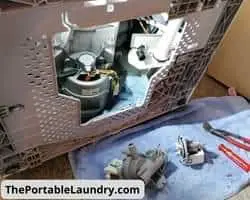
You may also need to tilt the machine with help of someone to access the lower back with ease.
Step 3: Unscrewed the Drain Hose clamp
Depending on the fixture loosen the hose clamp locking using a plier or by hand. If it is fixed using screws then simply unscrew the locks. Move the ring off the adjoining hose and drain outlet to either side.
Note – It is usually connected to either an “S” or “P” ring that holds it in place.
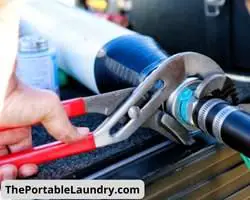
Step 4: Place the Container near the Drain Hose Connection Point
Be prepared for any leftover or clogged water that may spill out from the drain hose during the uninstallation.
In order to get around this, make use of large towels and lay them on the floor, next, place the container underneath the outlet to collect the spilling water.
Step 5: Remove the Drain Hose from the Washing Machine
Once the clamp is away simply pull out the existing drain hose from the outlet.
Be careful with water spilling around the floor at this stage.
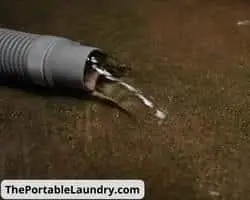
Step 6: Clean the Drain Area
Before you fix the replacement hose be sure to clean the drain area for any clogs. You can make use of a toothbrush to clean them.
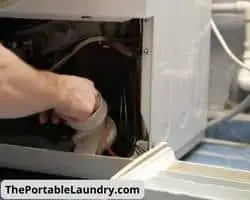
Step 7: Replace the Drain Hose
Once the drain hose area is thoroughly clean you may start fixing the replacement hose.
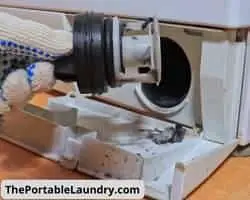
Step 8: Push the Drain Hose over the drain outlet
Now, push the new drain hose over the drain outlet of the washer and clamp them back for a sturdy gripping.
Step 9: Pour Water Into the washtub to check
Before you fix the machine back simply pour a small amount of water into the washtub to check if it is flowing freely off the drain hose.
Be sure to collect the tested water in a container to avoid wetting the floor.
If there is any leak observed towards the fixing area you may thread them with straps to prevent leakage.
Step 10: Move the Washer back to its position
Fix everything back and move the washer to its position.
Next, connect the power and water supplies and run a test cycle with your regular load.
Final Thoughts
Drain hoses are usually replaced every year or two during maintenance or servicing of your washer.
Replacing a worn-out drain hose can solve many problems and is relatively easy as it requires minimal effort.
Regular cleaning of the drain areas will reduce the frequency of replacing the drain hoses.
Always refer to the user manual of the washer for maintenance tips and components replacement guide before you proceed.
Frequently Asked Questions
Can I repair a broken drain hose?
If there is a slight tear in the drain hose, you may be able to fix it using straps and glue. While this might give you a temporary fix it may not assure you of the performance. The drain hoses do not cost much and replacement is a relatively easy task. Therefore, you are better off replacing the drain hose rather than spending a lot of time and effort on the repair.
Should I use my basin hose in my washer?
The hose of the basin may fix the washer but it is always better to buy a suitable drain hose designed for your washing machine model. Using unsuitable drain hoses may lead to voiding the warranty.
You May Also Like
- Are all washing machine hoses the same?
- How To Loosen Washing Machine Hose Safely? (Easy Guide)
- What is a Washboard? (Clothes Washing Board)
- How To Replace Washing Machine PCB Board?
- How to Replace The Outer Panels Of A Washing Machine?
- What are Washing Machine Transit Bolts? (Explained)
- Why are washing machines so heavy? (Explained)
- Are the LG Washing Machine Doors Reversible?
- What is a Steam Wash In LG washing Machine?
- How to Troubleshoot a Portable Washing Machine?
- How to Hook Up a Portable Washing Machine?





